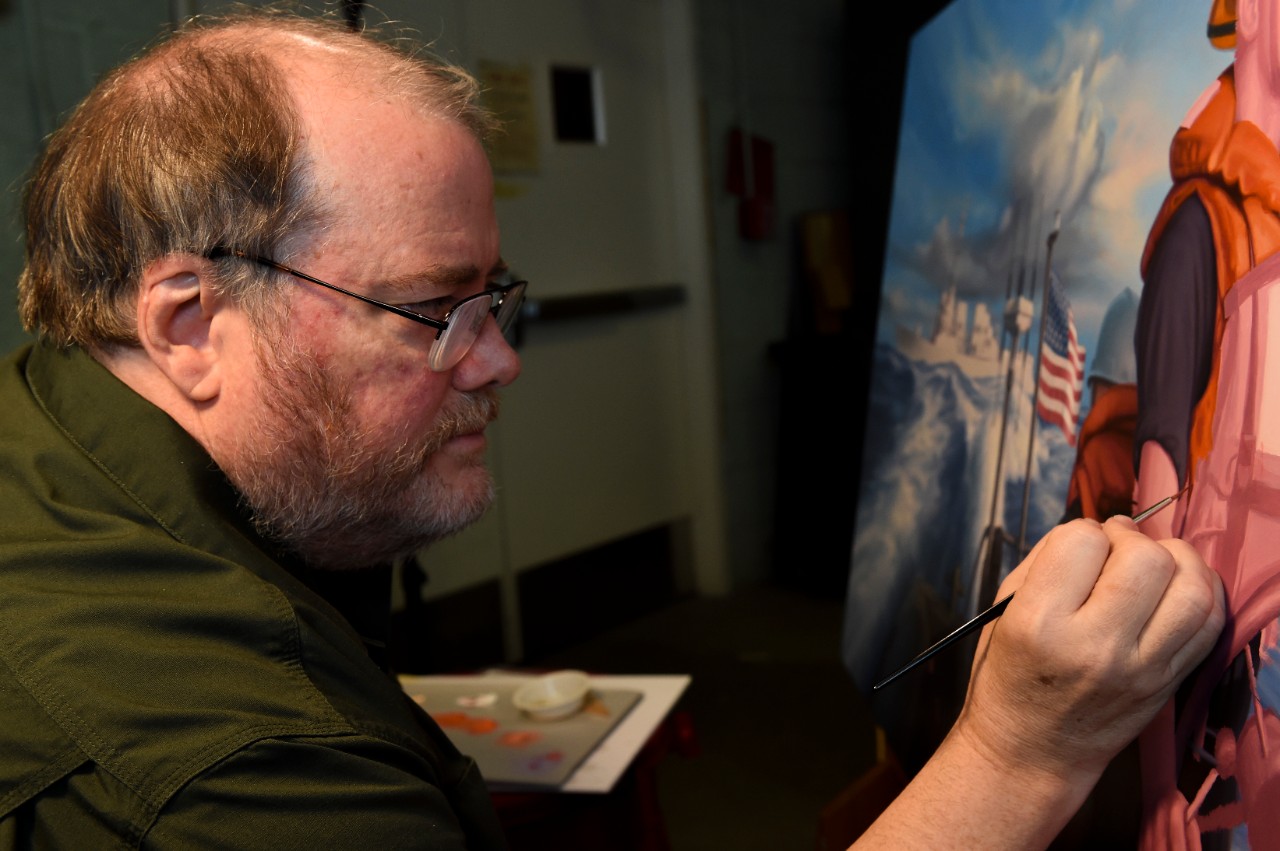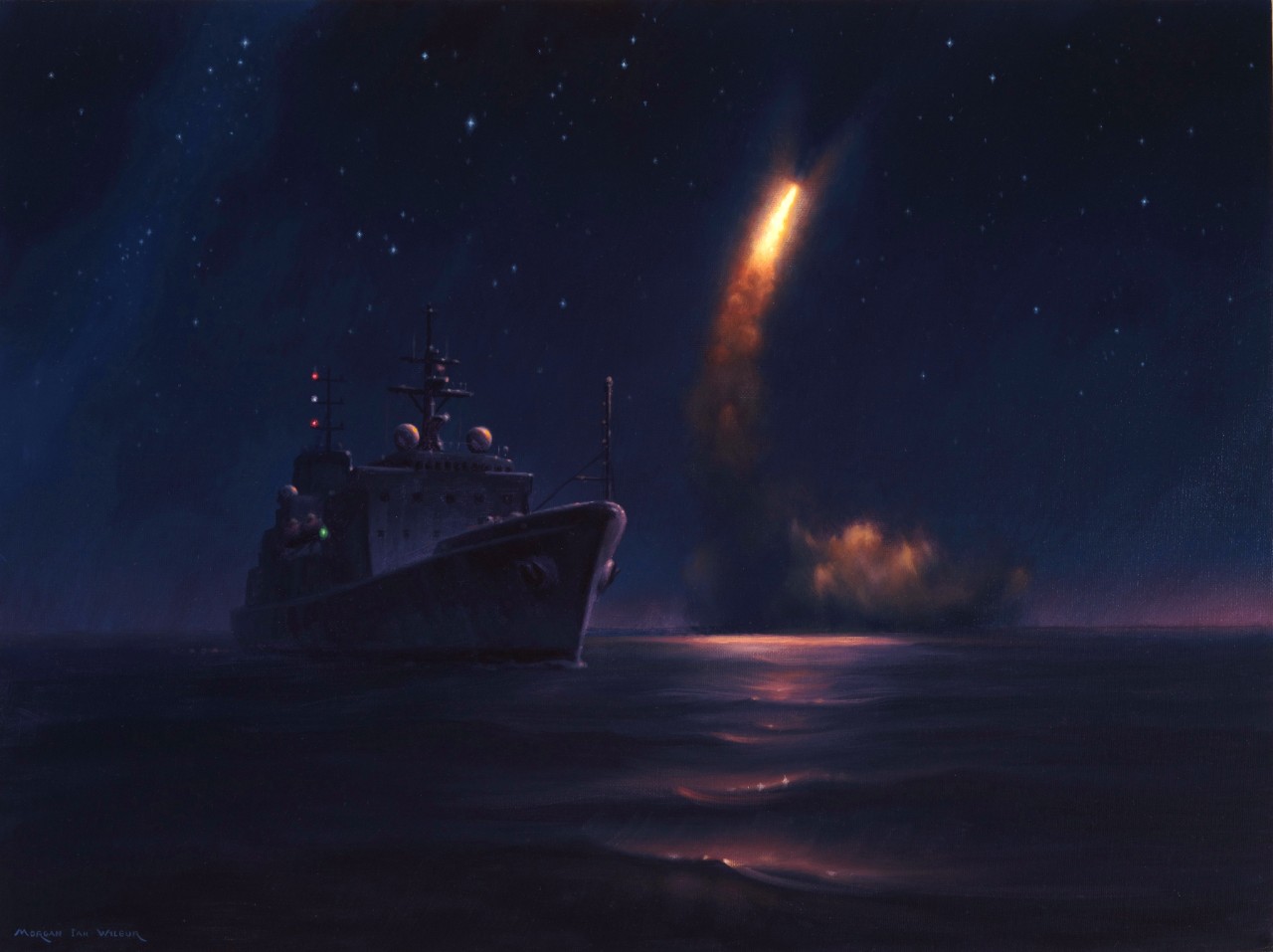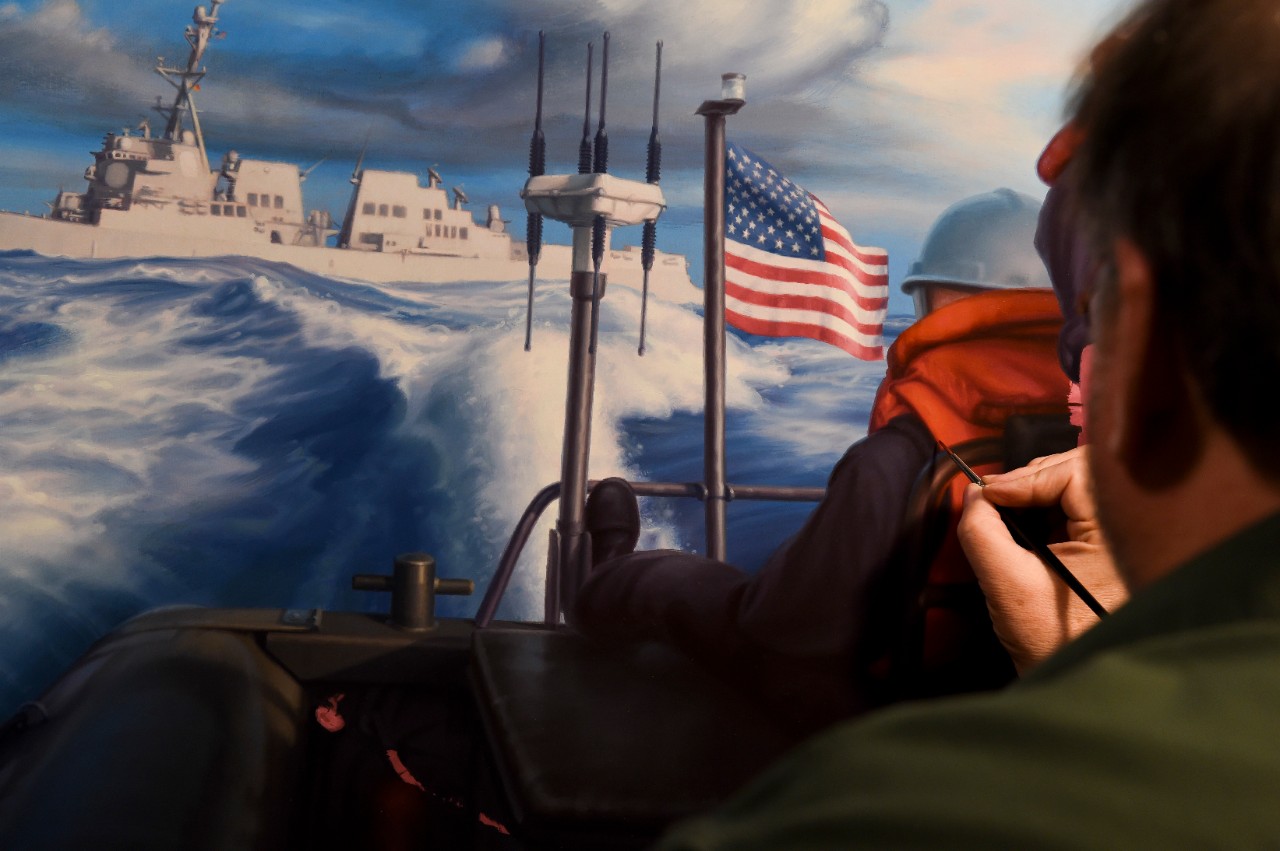WASHINGTON, D.C. – This space has become comfortable for, and inspires focus and passion in the two Navy combat artists who work there and who recount in discussion and with the delicate movement of brushes across canvas their most recent naval adventures.
By: Lt. j.g. Chloe J. Morgan, Naval History and Heritage Command, Communication and Outreach Division

For one of those artists, the Naval History and Heritage Command’s (NHHC) Morgan Wilbur, enthusiasm for recounting moments in the Navy’s history started early.
“My dad was a Navy pilot and an artist who has paintings in NHHC’s collection,” said Wilbur. “He taught me how to draw and paint. Plus, I grew up in Virginia Beach where I loved to watch Navy ships and aircraft.”
In 1965, the elder Wilbur, Ted, embarked the James Madison-class ballistic-missile submarine USS Nathanael Greene (SSBN 636) to document the 21st Polaris missile launch with watercolors. Fast forward five decades later, and Ted’s son Morgan was asked to undertake a similar mission.
On Nov. 7, 2015, Wilbur was invited by the U.S. Navy’s Strategic Systems Programs (SSP) office to document the test flight of an unarmed Trident II D5 Missile launched from the Ohio-class ballistic-missile submarine USS Kentucky (SSBN 737) in the Pacific Test Range off the coast of Southern California. Aboard the navigation test support ship USNS Waters (T-AGS 45), Wilbur was able to observe the night launch and capture what cameras could not.
“For night time operations like this, it is perfect to send an artist to document the event. I knew I could create a painting like this because I have never been able to see something like this photographed due to lighting issues,” Wilbur said. “By being there to witness the event in person, I was able to capture the full scope of the launch later in my painting.”

The painting, completed in 2016, is rich with imagery, illustrating the missile’s ascent to the starry night sky, the light from its rocket engine reflected in the choppy California waters.
For the painting, Wilbur chose a perspective off the ship in order to capture the Waters’ involvement in the operation. Mariners will notice that he took care to accurately capture the green starboard running light, and the red and white lights atop the mast telling all vessels in sight that the ship is restricted in her ability to maneuver.
“I want to get under the surface of what’s going on and still tell the story because that’s what we do here, we document and tell the story. With paintings you have so much leeway and it is up to the artist to organize the elements in there. Sometimes it will be close to what you saw, and other times there will be more editorial liberties.”
Navy combat art is documentary. Artists’ works illustrate the intensity of combat as personally experienced. Unlike the objective camera lens that records the single instant and no more, the artist not only captures instantaneous action, but can fuse earlier moments of the same scene into a compelling image. Observation, insight, elimination of confusing detail and focusing on the essential can all be compressed by the artist's eye.
Sometimes surrealism takes a prominent role in Wilbur’s work. In 2015, he completed a painting inspired by his time spent aboard the aircraft carrier USS George Washington (CVN 73). The ship was departing Yokosuka, Japan, and Wilbur chose to paint a cloud formation in the shape of a dragon over the carrier’s large deck to symbolize the location’s role.
“I see a way forward to impart my experience beyond the visual, beyond the surface details,” Wilbur said. “As a Navy artist you have to strike a balance because you are documenting and you don’t want to get so abstract that people don’t know what they are looking at, but you want the underlying story to show.”
Wilbur has traveled overseas to observe Operation Enduring Freedom and Operation Iraqi Freedom, with trips to Iraq in 2003, 2005 and 2006. According to Wilbur, those trips had a huge impact on him and his works.
“Those trips changed the focus of my art to people. I try to make sure to do half of my works on people just because I think those experiences reset the way I look at art,” Wilbur said. “I am now looking through a different filter and allow myself to include more of what was the real impact of what I saw, rather than just the surface.”
The Navy Combat Art Program was founded in 1941 because of the insight and persistence of Griffith Baily Coale, a well-known muralist. Believing that war was imminent and recognizing the value of having competent artists present at the scene of history-making events, Coale convinced top Navy commanders to send him and other artists into the field.
The program was revived with two military artists in the Korean War, and in the Vietnam era, the program operated with civilian artists in cooperation with the Salmagundi Art Club of New York. The Navy also began sending artists to cover a broader array of naval activities in addition to combat. Following the merger of the Navy Combat Art Program with the Naval History and Heritage Command, artists have covered naval operations around the globe.
The Combat Art Program is part of the Naval History and Heritage Command’s Navy Art Collection, which collects, documents, preserves and exhibits art that is significant to the history of the Navy. This includes more than 20,000 paintings, prints, drawings and engravings consisting of naval ships, personnel and actions from all eras of U.S. naval history. For more information on the Navy Art Collection, or to learn how you can request a combat artist to cover your command’s operations, visit NHHC’s online directory.

For more news from Naval History and Heritage Command, visit www.history.navy.mil.
NOTE TO MEDIA: For additional information about naval history, please contact the Naval History and Heritage Command’s Communication and Outreach division at 202-433-7880 or via email at NHHCPublicAffairs@navy.mil


